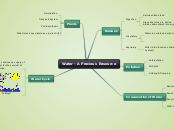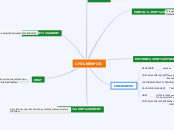The respiratory system provides oxygen and allows the circulatory system to perform its functions, and the circulatory system provides the organs in the respiratory system with nutrients and energy (from the digestive system)for growth and repairs.
The Digestive system provides material and nutrients for the circulatory system, and the circulatory system provides the organs in the digestive system with energy and nutrients to grow and repair.
Circulatory System
A small group of organs working to transport materials through the body.
Heart
The heart contains four chambers that pump blood to the lungs and to all body parts.
The heart acts as a double pump with the right side receiving deoxygenated blood from the different parts of the body.
The blood is then pumped to the lungs where oxygen diffuses into the blood and it becomes oxygenated.
The oxygenated blood then returns to the left side of the heart where it is pumped to all body parts.
Blood Vessels
(Arteries, veins, capillaries)
-Arteries are thick walled tubes that usually transport oxygenated blood to the body tissues from the heart.
-Veins are thinner walled tubes that usually transport deoxygenated blood from the body tissues to the heart.
-Capillaries are the site of exchange between the blood and body cells. They exchange oxygen, carbon dioxide, nutrients, wastes, and other materials.
Blood
Blood is made up of red blood cells, white blood cells, platelets, and plasma.
-The red blood cells are responsible for carrying oxygen, nutrients, and other materials to and from the tissues.
-White blood cells are mainly used as a defense against bacteria and other disease-causing organisms.
-Platelets assist with the clotting of blood
-plasma functions to carry many dissolved substances.
Digestive System
A large group of organs that work together to convert food and liquid into energy and basic nutrients that the body needs to grow and repair.
4 Main Processes
Ingestion
Taking in nutrients
Esophagus
A tube that moves food by process called peristalsis.
Prevents food from entering the trachea.
Leads to the trachea and esophagus.
Salivary glands
Produces saliva which helps to lubricate food so it may be swallowed more easily.
Rolls food into a ball so it is easier to swallow.
Teeth
Cutting, tearing, grinding and chewing food.
Egestion
The removal of waste from the body
Rectum
- ends at the anus
Large-Intestine
- the large intestine or colon is the place where water reabsorption occurs
Pancreas
- delivers enzymes to the duodenum to assist in the breakdown of nutrients
Gall bladder
- delivers bile to the first part of the small intestine called the duodenum
Liver
- processes foods that have been absorbed
- produces bile
- has many functions beyond those of involved in digestion
Absorption
The movement of digested nutrients into the tissues
Small-Intestine
- has villi and microvilli that improve the absorption of nutrients
- in addition to being the primary site of nutrient absorption, digestion is completed in the small intestine
Digestion
The breakdown of complex food molecules into smaller food molecules using enzymes.
Stomach
- the stomach contains gastric juices that are made up of hydrochloric acid and enzymes
- food is mixed and churned in the stomach
- there are sphincters at each end of the stomach to move food in or out
Explain how the functions of these three body systems are linked to provide the body with energy.
Respiratory System
A large group of organs working together to transport oxygen to the body and carbon dioxide to the external environment.
Larynx
A short section of the airway that connects the laryngopharynx and the trachea.
Also known as the voice box.
The larynx contains special structures known as vocal folds, which allow the body to produce the sounds of speech and singing.
The vocal folds are folds of mucous membrane that vibrate to produce vocal sounds.
The tension and vibration speed of the vocal folds can be changed to change the pitch that they produce.
Epiglottis
epiglottis ensures that air passes into the trachea by covering the opening to the esophagus.
During the process of swallowing, the epiglottis moves to cover the trachea to ensure that food enters the esophagus and to prevent choking.
Diaphragm
the primary muscle used in the process of inspiration, or inhalation.
Bronchi oles
The passageways by which air passes through the nose or mouth to the alveoli (air sacs) of the lungs
Bronchi
-Main passage into the lungs
Trachea
connects the larynx to the bronchi and allows air to pass through the neck and into the thorax.
The rings of cartilage making up the trachea allow it to remain open to air at all times.
The open end of the cartilage rings faces posteriorly toward the esophagus, allowing the esophagus to expand into the space occupied by the trachea to accommodate masses of food moving through the esophagus.
Pharynx
also known as the throat
A muscular funnel that extends from the posterior end of the nasal cavity to the superior end of the esophagus and larynx.
Tongue
The tongue is vital for chewing and swallowing food, as well as for speech.
Oral Cavity
-Secondary external opening for the respiratory tract. Also known as the mouth.
-The oral cavity can be used to supplement or replace the nasal cavity’s functions when needed.
Nasal Cavaty
-warms, moisturizes, and filters air entering the body before it reaches the lungs.
-Hairs and mucus lining the nasal cavity help to trap dust, mold, pollen and other environmental contaminants before they can reach the inner portions of the body.
-Air exiting the body through the nose returns moisture and heat to the nasal cavity before being exhaled into the environment.
Nose
The nose is a structure of the face that supports and protects the interior portion of the nasal cavity.








